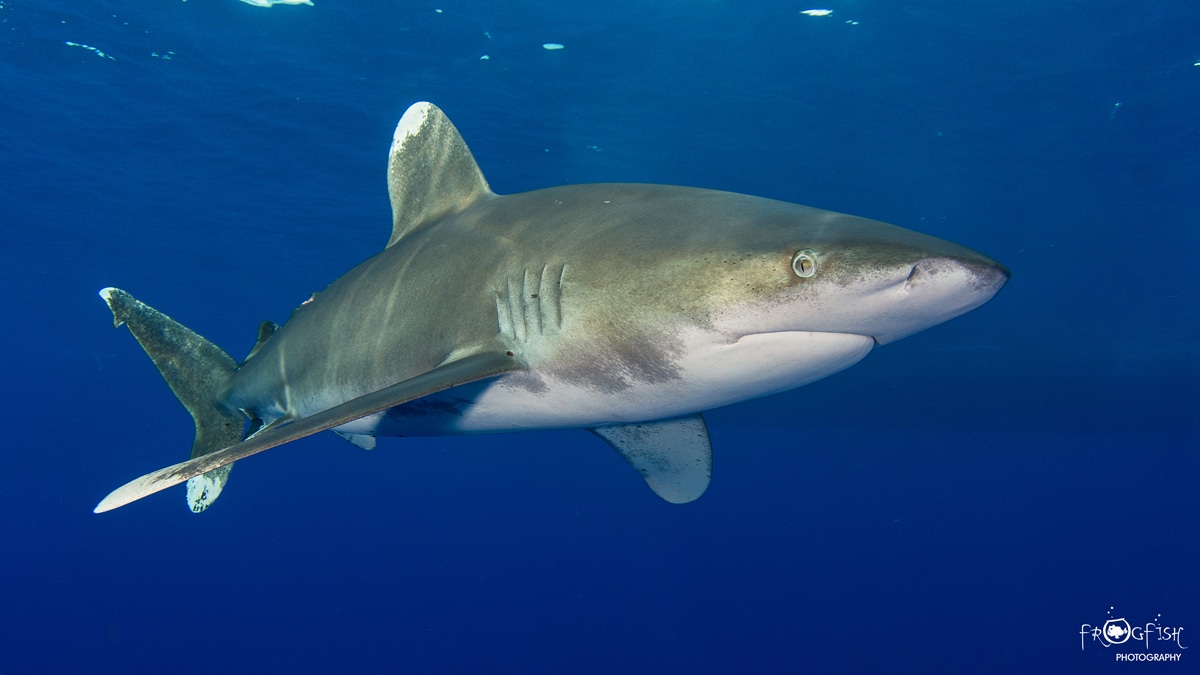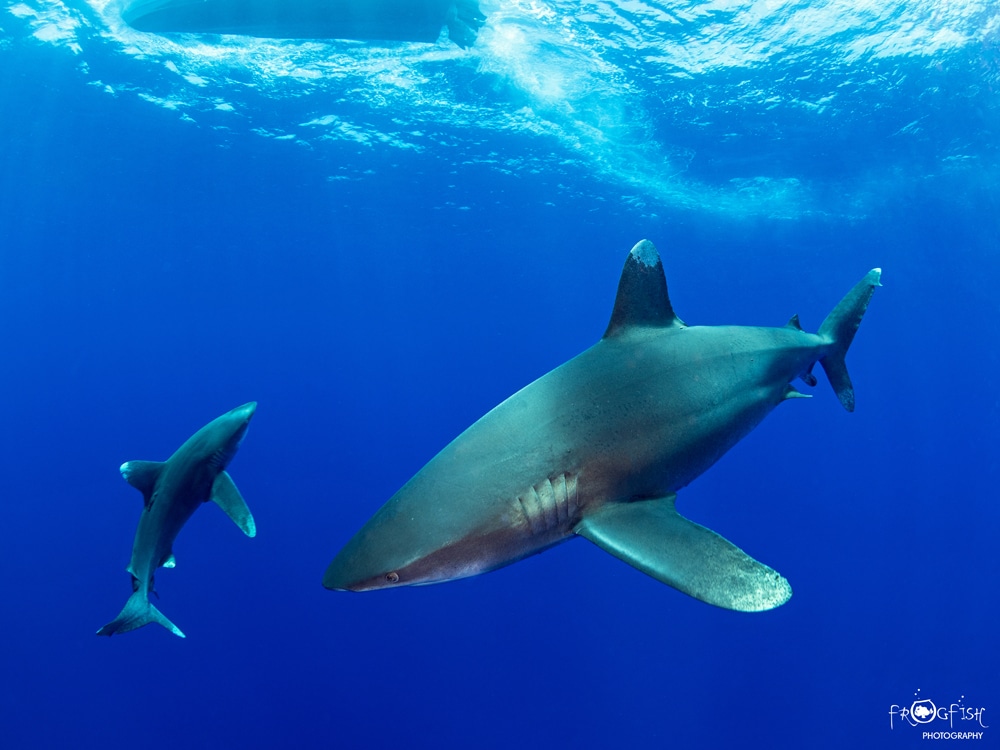Marine Life & Conservation Blogs
Creature Feature: Oceanic Whitetip Shark

 In this series, the Shark Trust will be sharing amazing facts about different species of sharks and what you can do to help protect them.
In this series, the Shark Trust will be sharing amazing facts about different species of sharks and what you can do to help protect them.
This month, it’s the turn of a legendary shark – the Oceanic Whitetip. Known for their incredibly long dorsal and pectoral fins, this species was once the most abundant oceanic-pelagic species of shark on the planet.
The Oceanic Whitetip is a species of shark in the same family (Carcharhinidae) as the Blacktip, Bull and Spinner Sharks, amongst others. Sharks in this family are also known as “requiem” sharks. “Requiem” is said to derive from the ancient Norman French word “reschignier” – to bare teeth or grimace.
Stocky and large, they are grey or brown above, and white below. Oceanic Whitetips are famous for their huge rounded first dorsal fin and paddle-like pectoral fins. Their fins have distinctive mottled white tips. They are slow moving, and active at day and night. Their huge pectoral fins spread out as they cruise at the surface.
They typically feed on oceanic bony fishes and cephalopods. However, they also eat stingrays, sea turtles, birds and crustaceans. They feed by biting into schools of fish or by swimming through schools with their mouth open. When feeding with other species, like Silky sharks, Whitetips can be aggressive. Peter Benchley, author of Jaws observed Whitetip sharks eating the faeces of Pilot Whales!
Like all sharks in the Charcharhinidae family, Oceanic Whitetips are viviparous. Embryos develop in utero and are fed by a placental sac. Mating season is in early summer for those in the Atlantic Ocean and southwest Indian ocean. Females in the Pacific have been found with embryos year round – suggesting a longer mating season. The gestation period is one year. Sexual maturity is reached at 4-9 years depending on location.
Whilst they are mostly solitary, Oceanic Whitetips do occasionally hunt in groups. These organised group hunts, during which Whitetips cooperate in hunts and strategically take turns in attacking prey.
Whitetips are incredibly inquisitive. Unfortunately, this means they are easy to catch. Combined with their low reproductive rate, they are incredibly at risk from population depletion. Previously listed as vulnerable, the Oceanic Whitetip was reclassified to critically endangered in 2019. Populations are declining across the globe, with declines of up to 99% reported in in the northwest and central Atlantic, for example.
Conservation efforts to help the species bounce back include listing on CITES Appendix II and CMS Appendix I, for example. They also have protection under some RFMOs (Regional Fisheries Management Organisations). However, these listings do not mean that Oceanic Whitetips are not still targeted or caught as bycatch in some parts of the world. With populations declining at such a high rate, further protections need to be implemented to ensure that the species can recover.
SCIENTIFIC NAME: Carcharhinus longimanus
FAMILY: Carcharhinidae
MAXIMUM SIZE: ~380cm long
DIET: Oceanic boy fishes and cephalopods. But also on stingrays, sea birds, turtles, marine gastropods, crustaceans, marine mammal carrion and garbage.
DISTRIBUTION: Worldwide – formerly the most abundant warm-water oceanic-pelagic shark.
HABITAT: Oceanic (occasionally coastal). Far off-shore, from surface to depths of 1082m. Temperatures between 18-28°c.
CONSERVATION STATUS: Critically endangered.
For more amazing facts about sharks and what you can do to help the Shark Trust protect them visit the Shark Trust website by clicking here.
Marine Life & Conservation Blogs
Creature Feature: Dusky Shark

 In this series, the Shark Trust will be sharing amazing facts about different species of sharks and what you can do to help protect them.
In this series, the Shark Trust will be sharing amazing facts about different species of sharks and what you can do to help protect them.
This month we’re taking a look at the Dusky Shark, a highly migratory species with a particularly slow growth rate and late age at maturity.
Dusky sharks are one of the largest species within the Carcharhinus genus, generally measuring 3 metres total length but able to reach up to 4.2 metres. They are grey to grey-brown on their dorsal side and their fins usually have dusky margins, with the darkest tips on the caudal fin.
Dusky Sharks can often be confused with other species of the Carcharhinus genus, particularly the Galapagos Shark (Carcharhinus galapagensis). They have very similar external morphology, so it can be easier to ID to species level by taking location into account as the two species occupy very different ecological niches – Galapagos Sharks prefer offshore seamounts and islets, whilst duskies prefer continental margins.
Hybridisation:
A 2019 study found that Dusky Sharks are hybridising with Galapagos Sharks on the Eastern Tropical Pacific (Pazmiño et al., 2019). Hybridisation is when an animal breeds with an individual of another species to produce offspring (a hybrid). Hybrids are often infertile, but this study found that the hybrids were able to produce second generation hybrids!
Long distance swimmers:
Dusky sharks are highly mobile species, undertaking long migrations to stay in warm waters throughout the winter. In the Northern Hemisphere, they head towards the poles in the summer and return southwards towards the equator in winter. The longest distance recorded was 2000 nautical miles!
Very slow to mature and reproduce:
The Dusky Shark are both targeted and caught as bycatch globally. We already know that elasmobranchs are inherently slow reproducers which means that they are heavily impacted by overfishing; it takes them so long to recover that they cannot keep up with the rate at which they are being fished. Dusky Sharks are particularly slow to reproduce – females are only ready to start breeding at roughly 20 years old, their gestation periods can last up to 22 months, and they only give birth every two to three years. This makes duskies one of the most vulnerable of all shark species.
The Dusky Shark is now listed on Appendix II of the Convention on the Conservation of Migratory Species (CMS), but further action is required to protect this important species.
Scientific Name: Carcharhinus obscurus
Family: Carcharhinidae
Maximum Size: 420cm (Total Length)
Diet: Bony fishes, cephalopods, can also eat crustaceans, and small sharks, skates and rays
Distribution: Patchy distribution in tropical and warm temperate seas; Atlantic, Indo-Pacific and Mediterranean.
Habitat: Ranges from inshore waters out to the edge of the continental shelf.
Conservation status: Endangered.
For more great shark information and conservation visit the Shark Trust Website
Images: Andy Murch
Diana A. Pazmiño, Lynne van Herderden, Colin A. Simpfendorfer, Claudia Junge, Stephen C. Donnellan, E. Mauricio Hoyos-Padilla, Clinton A.J. Duffy, Charlie Huveneers, Bronwyn M. Gillanders, Paul A. Butcher, Gregory E. Maes. (2019). Introgressive hybridisation between two widespread sharks in the east Pacific region, Molecular Phylogenetics and Evolution 136(119-127), https://doi.org/10.1016/j.ympev.2019.04.013.
Marine Life & Conservation Blogs
Creature Feature: Undulate Ray

 In this series, the Shark Trust will be sharing amazing facts about different species of sharks and what you can do to help protect them.
In this series, the Shark Trust will be sharing amazing facts about different species of sharks and what you can do to help protect them.
This month we’re looking at the Undulate Ray. Easily identified by its beautiful, ornate pattern, the Undulate Ray gets its name from the undulating patterns of lines and spots on its dorsal side.
This skate is usually found on sandy or muddy sea floors, down to about 200 m deep, although it is more commonly found shallower. They can grow up to 90 cm total length. Depending on the size of the individual, their diet can range from shrimps to crabs.
Although sometimes called the Undulate Ray, this is actually a species of skate, meaning that, as all true skates do, they lay eggs. The eggs are contained in keratin eggcases – the same material that our hair and nails are made up of! These eggcases are also commonly called mermaid’s purses and can be found washed up on beaches all around the UK. If you find one, be sure to take a picture and upload your find to the Great Eggcase Hunt – the Shark Trust’s flagship citizen science project.
It is worth noting that on the south coasts, these eggcases can be confused with those of the Spotted Ray, especially as they look very similar and the ranges overlap, so we sometimes informally refer to them as ‘Spundulates’.
Scientific Name: Raja undulata
Family: Rajidae
Maximum Size: 90cm (total length)
Diet: shrimps and crabs
Distribution: found around the eastern Atlantic and in the Mediterranean Sea.
Habitat: shelf waters down to 200m deep.
Conservation Status : As a commercially exploited species, the Undulate Ray is a recovering species in some areas. The good thing is that they have some of the most comprehensive management measures of almost any elasmobranch species, with both minimum and maximum landing sizes as well as a closed season. Additionally, targeting is entirely prohibited in some areas. They are also often caught as bycatch in various fisheries – in some areas they can be landed whilst in others they must be discarded.
IUCN Red List Status: Endangered
For more great shark information and conservation visit the Shark Trust Website
Image Credits: Banner – Sheila Openshaw; Illustration – Marc Dando
-

 News3 months ago
News3 months agoHone your underwater photography skills with Alphamarine Photography at Red Sea Diving Safari in March
-

 News3 months ago
News3 months agoCapturing Critters in Lembeh Underwater Photography Workshop 2024: Event Roundup
-

 Marine Life & Conservation Blogs2 months ago
Marine Life & Conservation Blogs2 months agoCreature Feature: Swell Sharks
-

 Blogs2 months ago
Blogs2 months agoMurex Resorts: Passport to Paradise!
-

 Blogs2 months ago
Blogs2 months agoDiver Discovering Whale Skeletons Beneath Ice Judged World’s Best Underwater Photograph
-

 Marine Life & Conservation2 months ago
Marine Life & Conservation2 months agoSave the Manatee Club launches brand new webcams at Silver Springs State Park, Florida
-

 Gear Reviews3 months ago
Gear Reviews3 months agoGear Review: Oceanic+ Dive Housing for iPhone
-

 Gear Reviews2 weeks ago
Gear Reviews2 weeks agoGEAR REVIEW – Revolutionising Diving Comfort: The Sharkskin T2 Chillproof Suit























